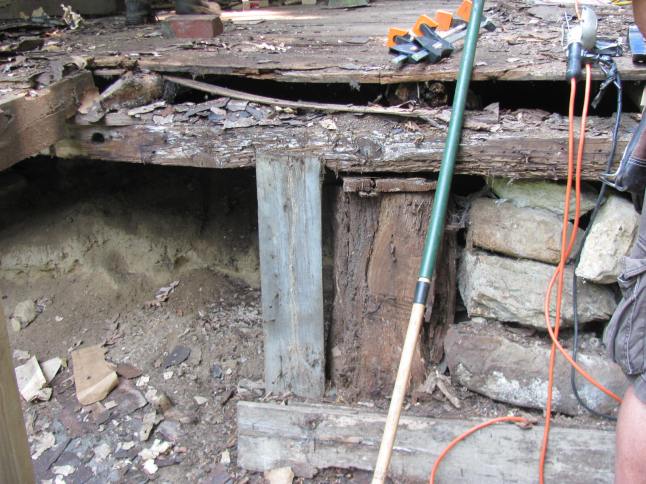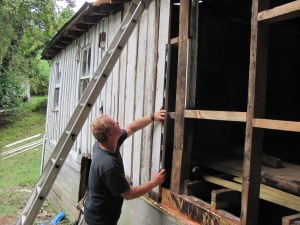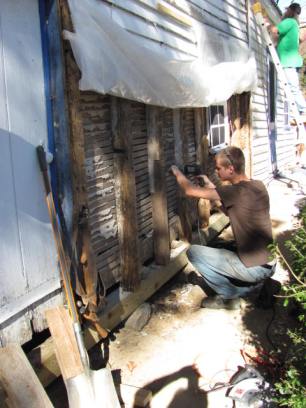The Fannie Roots house holds many stories, and Belmont staff and volunteers have been working quietly for many years to be able to share the tales this house represents. The house is named after Fannie Roots, the last person to live in the house. You might remember her dressed in her sun hat, leaning on her cane, tending her flowers or waving at those who passed by. The house, like Fannie Roots herself, has a rich and complex history.
Fannie Roots was a highly respected Stafford County citizen who was very active in local government, making a point of attending most Board of Supervisors meetings. She was honored at age 85 by the Stafford County Citizens’ Alliance, whose tax-fighting ways she supported. She was also very active in the Civil Rights movement during the 1960’s. Both Fannie Roots and her father worked intermittently in various positions at Belmont, and their home is a stark reminder that most people did not live in the luxury and comfort known by Gari and Corinne Melchers. She was a fiercely independent soul who managed to live on her own, with no indoor plumbing and only a wood stove for heat and cooking her entire life in the white house with the blue trim at the corner of Route 17 and Washington Street, adjoining Belmont.
She was born January 1st 1914, and died January 22nd 2004, meaning she spent 90 years watching Falmouth change from a busy little town to a small historic district overshadowed by big roads with lots of traffic zipping by. Falmouth is blessed with many interesting buildings, industrial ruins and other remnants of early Stafford County history, but visitors have to look hard to find them. The trail that goes through the woods at Belmont down to the Rappahannock River documents some of the cultural resources that remain, but there are many more pieces of Falmouth history that need to be brought to light.
The house she lived in was built after the Civil War, and Stafford family names such as Fritter, Hewitt and Payne are associated with its early history. My research dates the house to ca. 1880, and the builder used salvaged materials for sills and studs; ruins perhaps from the destruction of the recent war. The original house encompasses the gable roofed section with a shed roof kitchen and porch on the back. The building materials may have been salvaged from other structures, but it was well made, using traditional building techniques such as pegged sills and post in ground construction.

Detail of original post in ground construction
In 1885, George W. Payne, a plasterer, purchased the home and made improvements which included adding a room to the north and putting up fine plaster walls in the downstairs rooms. Fannie Roots’ father, Willie Roots, purchased the house in 1912. Mr. Roots and his wife Lettie Nelson Roots eventually had six children, necessitating the addition of another bedroom and the expansion of the kitchen. The upstairs room was never finished, and Fannie Roots told me in an interview in 2001 that the attic served as a very rustic sleeping space that was hot in the summer and cold in the winter.
Over time, electricity for lights and television were added, as well as a telephone. The house was never hooked up to a water and sewer system however, and Fannie Roots relied on her well and outhouse for those essentials. Layers of newspaper were used for insulation on both walls and floors throughout the house, and we have kept as much of the original material we possibly could to help interpret the conditions that existed before Belmont took ownership in 2008.

The house as it looked in spring of 2008.
The house was in terrible shape when we first entered the property; the roof and chimney had collapsed in the kitchen, sills had rotted out, and windows were broken; it was a rather daunting task to try and repair the place. We have worked slowly over the years with the help of volunteers and private donations. Dave Ludeker, our grounds maintenance manager, has been the main person on this job, making sure all repairs adhere to preservation standards, and engineering the detailed puzzle of putting the house back together again.

Dave Ludeker putting up siding.

Lars Mohs working on sistering in old studs to new sill.
Despite setbacks, such as a car driving through the gate and fence, and crashing through the north wall, we have been making improvements. Most of the structural work is now done, and I am very pleased to announce that we have received grants from the Duff McDuff Green Fund and the Fredericksburg Savings Charitable Foundation to repair the roof, so watch this spring as further improvements are made.

Truck crashing through the wall was a “minor” set-back!
Fannie Roots garden, and the paint scheme of the house tell a story as well. The simple wire hoop fence with white posts and stones, and the white gate with an old-fashioned rose is a wonderful example of African-American garden traditions. The vivid blue paint, traditionally called “haint blue” is another example of African American cultural expression. A “haint” is a spirit or a ghost, and the blue paint was thought to prevent them from entering the doors and windows.
New fence and gates were installed this winter, and are ready for paint this spring. The new roof will be added in the spring as well.
The Roots House is a great opportunity to learn about the history of the people who lived in the cottage and it represents a rare example of how the majority of Stafford County citizens lived after the Civil War up through the early twentieth century. This type of housing does not usually survive, as most were torn down as soon as the owner’s economy allowed. It is very important that this cottage is saved for the future as a place where people can see how the working class of that period lived; the house is a vivid reminder that much has changed in the last century and a half.
We hope to have an open house this fall to share the stories this building tells, – the story of ordinary people, – the tradesmen, workers, and women who represent the people who made Falmouth their home. Stay tuned for more information as we continue the work to preserve the building for the future.
Monetary support for the project is still needed, to contribute contact David Berreth 540-654-1840, dberreth@umw.edu, or Beate Ankjaer-Jensen, 540-654-1839, bjensen@umw.edu.

One thought on “Fannie Roots House”